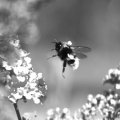Chemical contamination of the marine environment in some parts of Antarctica has been investigated by a University of Queensland researcher.
Preliminary results from experiments on marine organisms from a bay next to a former research station tip site have shown high rates of fish with parasites, abnormally shaped heart-urchins and low survival rates in crustaceans.
Ecotoxicologist Dr Sabine Duquesne from the University's National Research Centre for Environmental Toxicology (NRCET) has spent nine weeks at Casey Station, as part of a three-year marine ecotoxicology project.
She believes that human activities in Antarctica have an impact on the marine life of the world's last relatively unpolluted continent.
'However, this impact is very localised to some areas.
'Antarctica is the driest, coldest, windiest, highest and most remote place on Earth,' Dr Duquesne said.
'No large land animals live permanently on the continent, but the waters surrounding Antarctica teem with life.'
The research has also involved new sampling techniques and has shown that global warming would make marine life even more sensitive to chemical contaminants.
'Assuming that global warming would increase the summer melt of the ice and decrease the salinity close to the shore, the synergistic effects of contaminants with salinity or temperature changes were tested,' Dr Duquesne said.
'With these conditions the tested species were much more sensitive to toxicity of heavy metals. So, climate change could change the susceptibility of Antarctic ecosystems to pollutants.'
Dr Duquesne said the main sources of pollution were old tip sites dating back to before the requirement for 'Return to Australia' was established in all Australian research stations.
The project is looking at the environmental impact of contaminants from a tip site which operated between 1965 and 1986. Domestic and construction waste was periodically dumped and burned. The remaining rubbish was sometimes bulldozed onto the sea-ice to eventually sink into Brown Bay with the summer melt.
Dr Duquesne said the dumped materials have the potential to leach into the adjacent bay. They have elevated levels of heavy metals, in particular copper, lead and zinc.
'This research aims at monitoring the dispersion of the pollutants , and at determining their effects on the marine organisms as well as the sensitivity of Antarctic species to chemical contamination and to natural stress,' she said.
Samples of fish, holothurians, heart urchins, starfish, krill, gammarids, seawater and sediment were brought back to Brisbane for analyses to determine the extent of the effects of the contaminants leaching out of the tip site.
Toxicity tests were carried out in a refrigerated aquaria system designed by the Australian Antarctic Division specifically for this project.
The system, made of two shipping containers, includes 20 aquaria, cleaning facilities for the water spiked with heavy metals or organic contaminants, and storage of four cubic metres of seawater.
Dr Duquesne said that although the environment is extreme and pristine, the preliminary tests showed that Antarctic marine organisms are no more sensitive to contaminants than temperate species.
Research will continue next summer, especially for establishing management strategies.
'It is very exciting,' said Dr Duquesne. 'There is much more work to do for this project. We need to get complementary data on the effects of run-offs of meltwater in the bay, and of the temperature increase. This will allow us to better assess if the risk of such tip sites should be managed either by removing the material and returning it to Australia or by isolating it in place.'
The research would also provide urgently needed information for the development of appropriate standards and strategies for protection of the Antarctic, sub-Antarctic and Southern Ocean, she said.
The project is part of the Human Impact program from the Australian Antarctic Division which last season involved seven scientists with different fields of expertise.
The group of ecotoxicologists also included Dr Mathias Liess from the University of Braunschweig in Germany, Martine Greve, a Master of Science student from the University of Groningen in The Netherlands, and Cathy King, PhD student at the University of Sydney.
For more information contact Dr Duquesne on (07) 3274 9009 or (07) 3274 9147.



